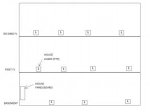Designer69
Senior Member
I have a dorm building with individual dwelling units and separate boarding type areas with individual sleeping rooms, corridors etc.
there are multiple occupied levels and a basement where the electrical equipment is stored.
The house panel is in the basement and all loads (receptacles, lights etc.) on first and second floors will have to be fed by the house panel.
Would an electrician actually do it this way and wire home runs to the upper floors from the basement house panel or is it a must he would install additional house panels on each individual floor?
Thank You
there are multiple occupied levels and a basement where the electrical equipment is stored.
The house panel is in the basement and all loads (receptacles, lights etc.) on first and second floors will have to be fed by the house panel.
Would an electrician actually do it this way and wire home runs to the upper floors from the basement house panel or is it a must he would install additional house panels on each individual floor?
Thank You


